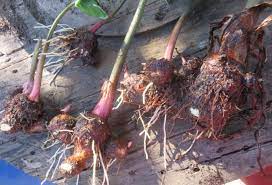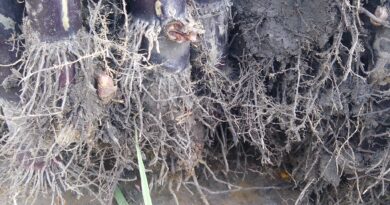Cocoyam Tuberous Roots: Economic Importance, Uses, and By-Products
Cocoyam Tuberous roots are the edible part and are typically underground. They have a rough, brownish outer skin and a creamy to white flesh on the inside. The flavor and texture of cocoyam roots are somewhat similar to potatoes, but they can vary in taste and texture depending on the variety and how they are prepared.
Cocoyam (Xanthosoma sagittifolium and Colocasia esculenta) is a starchy tuberous root vegetable that is a staple in many tropical and subtropical regions around the world. It is known by various names, such as taro, dasheen, eddoe, and yautia, depending on the region. Cocoyam roots are a significant source of carbohydrates and provide essential nutrients such as fiber, vitamins, and minerals. They are often used in traditional dishes, soups, stews, and can be boiled, steamed, mashed, fried, or used in a variety of culinary applications.
In some cultures, cocoyam leaves are also consumed as a leafy vegetable and are a good source of vitamins and minerals. It’s important to note that cocoyam leaves and roots must be properly cooked to remove any potentially harmful substances, as they can be toxic when raw or undercooked.
The Economic Importance and Uses of Cocoyam Tuberous roots
Cocoyam (Colocasia esculenta) is a root vegetable widely cultivated and consumed in various parts of the world.
The tuberous roots of cocoyam have several economic importance and uses:
1. Food Source: Cocoyam tuberous roots are a significant source of carbohydrates in many diets around the world. They are consumed in various forms, including boiled, fried, roasted, or mashed, and are used to make traditional dishes, stews, soups, and snacks.
2. Diversity of Dishes: Cocoyam tubers are versatile in culinary applications. They can be used to prepare a wide range of dishes such as cocoyam porridge, cocoyam fufu, cocoyam chips, and cocoyam flour for baking.

3. Dietary Nutrients: Cocoyam tubers are rich in essential nutrients such as dietary fiber, vitamin C, vitamin B6, potassium, manganese, and folate. These nutrients are crucial for maintaining a healthy diet and can help prevent certain nutritional deficiencies.
4. Livelihood and Income Generation: The cultivation, processing, and sale of cocoyam tubers contribute to the livelihoods of many farmers and traders. It serves as a source of income for rural communities and small-scale farmers who grow and sell cocoyam in local markets.
5. Export and Trade: Cocoyam tubers can be exported to international markets, contributing to the economy through foreign exchange earnings. In regions where cocoyam is not grown locally, there is a market for imported cocoyam products.
Read Also: Dates Calyx: Economic Importance, Uses and By-Products
6. Crop Rotation and Soil Health: Cocoyam is often used in crop rotation systems to improve soil health. The plant helps to break up compacted soils and adds organic matter, which enhances the soil’s fertility and structure for subsequent crops.
7. Culinary Innovation: Cocoyam tubers are used to create innovative culinary products such as cocoyam chips, which offer a healthier alternative to traditional potato chips. These innovations can cater to a growing market seeking diverse and healthy snack options.
8. Culinary Tourism: Cocoyam-based dishes and products can attract culinary tourism, showcasing the local culture and traditions associated with cocoyam consumption. This can boost tourism and local economies.
9. Livestock Feed: In some regions, cocoyam tubers are used as animal feed, providing a valuable source of nutrition for livestock. The leaves and stems of the cocoyam plant are also utilized as fodder.
10. Sustainable Crop: Cocoyam is relatively easy to grow and manage, making it a sustainable crop choice for small-scale farmers. It requires less intensive care compared to some other root crops, making it accessible to a wider range of farmers.
The Products and By-products That Can Be Derived From Cocoyam Tuberous roots
Cocoyam, also known as taro or dasheen, is a root vegetable native to tropical regions and is widely cultivated for its edible corms (tuberous roots). The corms of cocoyam can be used to produce a variety of products and by-products, each with its own uses and applications.
Here’s a list and explanation of the products and by-products that can be derived from cocoyam tuberous roots:
1. Cooked Cocoyam: The most common and straightforward product is boiled, steamed, or roasted cocoyam, which is a staple food in many cultures. The corms can be cooked and served as a side dish or incorporated into various recipes.
2. Flour: Cocoyam corms can be processed into flour after drying and grinding. Cocoyam flour can be used in a variety of recipes such as pancakes, bread, cakes, and pastries.
3. Starch: Cocoyam starch is obtained through a process that involves washing, peeling, and grinding the corms. The resulting starch can be used in food processing, as a thickening agent, or in the production of confectioneries.
4. Fermented Products: Fermented cocoyam products like “fufu” and “sour starch” are popular in many African and Caribbean cuisines. Fermentation improves the flavor and nutritional value of the corms.
5. Chips and Snacks: Cocoyam corms can be sliced and fried to produce chips and other snacks, providing a crunchy and tasty alternative.
6. Cocoyam Fritters: A batter made from cocoyam flour can be used to make fritters, which are deep-fried and can be served as appetizers or snacks.
7. Canned or Jarred Cocoyam: Cocoyam can be canned or jarred, either whole or sliced, for longer shelf life and easy storage.
8. Baby Food: Cocoyam can be used to prepare baby food due to its nutritional content and mild flavor. It’s often mashed or pureed for young children.
9. Animal Feed: The by-products and waste from cocoyam processing, such as peels and trimmings, can be utilized as feed for livestock and poultry.
10. Biodegradable Packaging Material: Some researchers have explored the potential of using cocoyam starch to produce biodegradable packaging materials, providing an eco-friendly alternative to conventional plastic.
11. Medicinal Extracts: Cocoyam tubers contain compounds with potential medicinal properties, and extracts may be used in traditional medicine or pharmaceutical applications.
12. Biofuel Production: Cocoyam tubers can also be used in biofuel production through the extraction and conversion of oils for biodiesel.
In conclusion, cocoyam tuberous roots play a significant role in providing nutrition, income, employment, and culinary diversity, making them an important agricultural commodity with a variety of economic and social benefits.
Read Also: The Essential Guide to Waste Management









